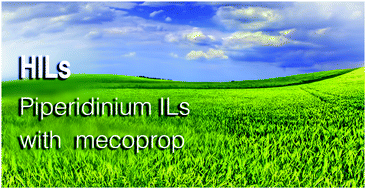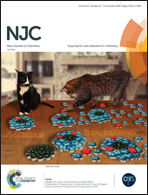Synthesis and properties of ionic liquids based on mecoprop†
Abstract
Ionic liquids with the mecoprop anion and 1-alkyl-1-methylpiperidinium cation were synthesized by using a two-step approach. In the obtained homologue series the alkyl chain ranged from two to eighteen atoms. Basic physicochemical properties such as density, viscosity and refractive index as well as solubility in water and common organic solvents were determined for the prepared ILs. Additionally, thermal stability and phase transitions were analysed by differential scanning calorimetry. The synthesized homologues were thermally stable. The values of Tonset amounted to approx. 230 °C for all ILs. The efficacy of the obtained ILs was investigated under greenhouse conditions to establish the influence of the alkyl chain length on the herbicidal activity. The results of the tests showed that the chain length had an influence on the herbicidal efficacy. Taking all the test plants into account (common lambsquaters, white mustard, and cornflower), the highest efficacy was observed in the case of ILs with a short alkyl chain, including 5–6 carbon atoms, and a long chain ranging from 16 to 18 carbon atoms. An inhibitory influence of the tested ILs on the development of the lambsquaters root system was also observed. The herbicidal ionic liquids obtained in the framework of this study, which were not previously described in the literature, are characterized by two areas of intense activity in the homologue series. Simultaneously, novel forms of mecoprop were synthesized in the form of ionic liquids.



 Please wait while we load your content...
Please wait while we load your content...